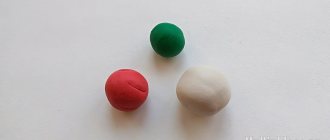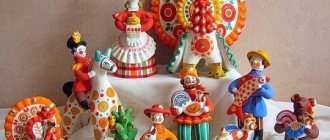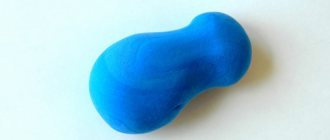Summary of GCD on modeling on the topic: “Felt boots” in the senior group
Goal: to teach children to sculpt felt boots in an unconventional way - plasticineography.
Tasks:
Educational:
1. To develop skills in working in the plasticineography technique - pinching, smearing, decorating the product using (beads, rhinestones, seed beads, sequins).
2. Enriching and updating children’s knowledge about the variety of shoes, their purpose, and use depending on the time of year.
Correctional and developmental:
1. Development of fine motor skills of the hands.
2. Development of perception and sensation.
3. Development of mental operations and inferences.
4. Form nouns with a diminutive suffix.
Educational:
1. Cultivate accuracy in work.
2. Formation of perseverance.
Integration of educational areas:
NGO “Cognitive Development”, NGO “Artistic and Aesthetic Development”, NGO “Speech Development”, NGO “Physical Development”.
Preliminary work : work on a lexical topic, looking at illustrations with different types of shoes, reading K. Chukovsky’s “Miracle Tree”.
Forms of educational activities : subgroup, gaming, communicative.
Methods and techniques : verbal, practical, visual.
Materials and equipment:
For the teacher : pictures with shoes, sample “Felt boots”.
For children: plasticine, napkins, additional material for decorating the work, “Felt felt boots” templates.
Progress of the lesson:
Organizing time:
Children stand in a circle We came to kindergarten (imitate walking) Gosha is happy and Tikhon is happy, And of course all the guys (clap our hands) We are very happy to meet you! Guys, I’m glad to see you so cheerful and healthy, how are you feeling? May your good mood remain with you all day. Give a smile and good mood to our guests.
Main part.
Educator:
The phone rings. The teacher picks up the phone and answers:
- Hello? Who's speaking? An old man from a forest hut? What has happened with you?
Guys, the Old Forester cannot find his shoes, he looked for them under the stove, and under the table, and under the bench - they are nowhere to be found. How can he now get around his forest possessions? What advice would you give him? (Children's answers.)
Guys, what are shoes even for? Is it possible to do without it? (Children's answers.)
Lesovichok said that he had sandals and would wear them on the street in winter. Is it possible to walk through the forest in sandals in winter? Children: no! because it will freeze.
Educator: Of course, guys, what kind of shoes should you wear in winter? (in winter).
Educator: Well, guys, let’s help the forester? (Yes.) Now I’ll call him: Hello, Lesovichok, don’t worry. We will definitely help you. The skillful hands of our children will make new winter shoes for you.
Educator: Guys, our little forest boy is small, which means his shoes are small, and if we have galoshes, then the little forest boy has sneakers, sneakers, shoes, sandals, sandals, boots, boots, felt boots) - GAME WITH A BALL.
Educator: And now, guys, I’ll tell you a riddle. Mystery:
An adult knows
Even the little one knows
So as not to get sick in winter.
They put on …. (felt boots).
Educator: of course, guys, these are felt boots, frosts and snowstorms are not scary in felt boots, these are very warm shoes. They are made from natural sheep wool. And today we will make unusual felt boots, and in an unusual way - from plasticine. And to make the felt boots beautiful, we will decorate them (with beads, beads, sequins). But first we'll take a little rest
Now sit down at the tables and you and I will become master shoe designers, we will make and decorate felt boots.
The teacher shows the sample, examines it, and explains the teacher.
Look, the felt boots have a wide shaft, a flat sole and a rounded toe. For my felt boots, I chose green plasticine and decorated it with sequins and beads.
— Before starting work, you need to choose the plasticine that you like, apply the plasticine to the felt boot template. After pinching off a piece and applying it to the cardboard, after finishing this work, we will begin decorating the felt boots. You will come up with the patterns yourself, but you must remember that the pattern must be beautiful.
But before we get started, we'll play with our fingers.
Finger gymnastics:
One, two, three, four, five Let's count shoes: One - shoes, The child bends his fingers. Two - boots, Three boots, Four - sandals And, of course, slippers - five. Hands need to rest. (After finger gymnastics, the teacher and the children begin to work.) Look at how to do it. I pinch off a piece of plasticine and stick it to the cardboard. Educator: look at the fabulous felt boots you got. Guys, do you think the Old Forest Man will like your work? Let's put them in a box and send the parcel to the forest.
Final part.
Educator:
— What did you like most?
- What have we learned today?
Reflection.
Children choose emoticons and take them for themselves (smile - they liked the activity, sad - they did not like the activity.
Goal: to teach children to sculpt felt boots in an unconventional way - plasticineography.
Tasks:
Educational:
1. To develop skills in working in the plasticineography technique - pinching, smearing, decorating the product using (beads, rhinestones, seed beads, sequins).
2. Enriching and updating children’s knowledge about the variety of shoes, their purpose, and use depending on the time of year.
Correctional and developmental:
1. Development of fine motor skills of the hands.
2. Development of perception and sensation.
3. Development of mental operations and inferences.
4. Form nouns with a diminutive suffix.
Educational:
1. Cultivate accuracy in work.
2. Formation of perseverance.
Integration of educational areas:
NGO “Cognitive Development”, NGO “Artistic and Aesthetic Development”, NGO “Speech Development”, NGO “Physical Development”.
Preliminary work : work on a lexical topic, looking at illustrations with different types of shoes, reading K. Chukovsky’s “Miracle Tree”.
Forms of educational activities : subgroup, gaming, communicative.
Methods and techniques : verbal, practical, visual.
Materials and equipment:
For the teacher : pictures with shoes, sample “Felt boots”.
For children: plasticine, napkins, additional material for decorating the work, “Felt felt boots” templates.
Progress of the lesson:
Organizing time:
Children stand in a circle We came to kindergarten (imitate walking) Gosha is happy and Tikhon is happy, And of course all the guys (clap our hands) We are very happy to meet you! Guys, I’m glad to see you so cheerful and healthy, how are you feeling? May your good mood remain with you all day. Give a smile and good mood to our guests.
Main part.
Educator:
The phone rings. The teacher picks up the phone and answers:
- Hello? Who's speaking? An old man from a forest hut? What has happened with you?
Guys, the Old Forester cannot find his shoes, he looked for them under the stove, and under the table, and under the bench - they are nowhere to be found. How can he now get around his forest possessions? What advice would you give him? (Children's answers.)
Guys, what are shoes even for? Is it possible to do without it?
(Children's answers.)
Lesovichok said that he had sandals and would wear them on the street in winter. Is it possible to walk through the forest in sandals in winter? Children:
No! because it will freeze.
Educator:
Of course guys, what kind of shoes should you wear in winter? (in winter).
Educator:
Well, guys, let's help the forester? (Yes.) Now I’ll call him: Hello, Lesovichok, don’t worry. We will definitely help you. The skillful hands of our children will make new winter shoes for you.
Educator:
Guys, our little forest boy is small, which means his shoes are small, and if we have galoshes, then the little forest boy has sneakers, sneakers, shoes, sandals, sandals, boots, boots, felt boots) - GAME WITH A BALL .
Educator:
And now guys, I’ll tell you a riddle.
Riddle:
An adult knows
Even the little one knows
So as not to get sick in winter.
Put on ….
(felt boots).
Educator: of course, guys, these are felt boots, frosts and snowstorms are not scary in felt boots, these are very warm shoes. They are made from natural sheep wool. And today we will make unusual felt boots, and in an unusual way - from plasticine. And to make the felt boots beautiful, we will decorate them (with beads, beads, sequins). But first we'll take a little rest
Now sit down at the tables and you and I will become master shoe designers, we will make and decorate felt boots.
The teacher shows the sample, examines it, and explains the teacher.
Look, the felt boots have a wide shaft, a flat sole and a rounded toe. For my felt boots, I chose green plasticine and decorated it with sequins and beads.
— Before starting work, you need to choose the plasticine that you like, apply the plasticine to the felt boot template. After pinching off a piece and applying it to the cardboard, after finishing this work, we will begin decorating the felt boots. You will come up with the patterns yourself, but you must remember that the pattern must be beautiful.
But before we get started, we'll play with our fingers.
Finger gymnastics:
One, two, three, four, five Let's count shoes: One - shoes, The child bends his fingers.
Two - boots, Three boots, Four - sandals And, of course, slippers - five.
Hands need to rest. (After finger gymnastics, the teacher and the children begin to work.) Look at how to do it. I pinch off a piece of plasticine and stick it to the cardboard. Educator:
look at the fabulous felt boots you got. Guys, do you think the Old Forest Man will like your work? Let's put them in a box and send the parcel to the forest.
Final part.
Educator:
— What did you like most?
- What have we learned today?
Reflection.
Children choose emoticons and take them for themselves (smile - they liked the activity, sad - they did not like the activity.
Summary of a lesson on modeling using plasticineography technique “Let's decorate the dress”
Svetlana Ovchinnikova
Summary of a lesson on modeling using plasticineography technique “Let's decorate the dress”
Tasks:
•Continue to introduce children to clothing, teach them to name significant details and parts of objects;
Continue to learn how to sculpt using the plasticine technique ;
Develop fine motor skills of fingers;
Create a joyful mood and satisfaction from the results of work;
Cultivate interest in modeling and perseverance.
Basic knowledge, skills and abilities of children: they have an idea of clothing, its types, name the essential details and parts of clothing, can, if desired, depict types of clothing. Preliminary work: role-playing games “Atelier”
,
“Clothes Store*4”
, games with dolls, looking at clothes, looking at buttons, didactic games and exercises, conversations about clothes, looking at illustrations with images of clothes, making children
(under the guidance of a teacher)
template
with plasticine stuck on using the stretching method plasticineography technique .
Materials and equipment: dolls in dresses , a drawn doll without a dress dress templates coated with plasticine , plasticine of different colors , oilcloths, wet wipes, didactic exercise “Assemble a dress ”
.
Contents of the lesson .
1. Introductory part. The teacher draws the children’s attention to the things they are wearing, asks them to look at them carefully, and name what clothes the girls have and what clothes the boys have.
2. Conversation between the teacher and the children.
Teacher. Guys, what parts does the dress ? (Sleeves, skirt, jacket, collar, buttons, belt.)
(Shows a picture of a doll)
.
And my doll Katya doesn’t have a dress .
Didactic exercise “Assemble a dress ”
.
The teacher invites the children to assemble a whole dress from parts . The teacher asks to name the color of each dress . Children select buttons (circles)
to match the color
of the dress .
Teacher. Guys, let's please all the dolls in our group and give them a gift - new dresses .
3. Practical part. Children sit at tables, each child has dress templates of different colors prepared in advance by the children, plasticine of different colors and a picture of a dress . The children look at the picture and find out that the dress is ugly and needs to be decorated . The teacher tells the children how best to do this, what decorative details to use, and shows several options (samples)
.
Physical education lesson (optional by teacher)
.
4. Final part. Playing out the finished products: children take their finished works to the play corner and give them to the dolls.
Literature: N. N. Leonova. Artistic and aesthetic development in the preschool group of preschool educational institutions. Long-term planning, notes . Publishing House "Childhood-Press"
. 2015. p. 176







